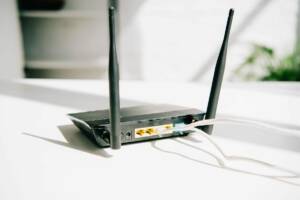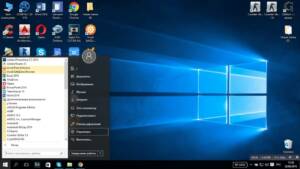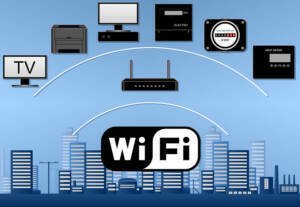Connecting Wi-Fi on a laptop may seem like a difficult task for beginners, but it is actually very simple. In this guide, we will show you how to connect Wi-Fi on a laptop step by step.
- Step 1: Prepare for Wi-Fi Connection
- Step 2: Turn on Wi-Fi on your laptop
- Step 3: Find a Wi-Fi network
- Step 4: Enter your Wi-Fi network password
- Where to start: checking for a Wi-Fi adapter and turning it on
- Entering a password: how to correctly enter the password for a Wi-Fi network
- Problem solving: what to do if your laptop does not connect to Wi-Fi
- Security settings: how to protect your Wi-Fi network
- Changing your password: how to change your Wi-Fi network password for more security
- MAC address filtering: what is it and how to configure it
- Enabling a firewall: how to provide additional protection for your Wi-Fi network
- Additional Tips: How to Improve Wi-Fi Signal Quality
- Using a signal booster: advantages and disadvantages
- Updating Drivers: Why It's Important and How to Do It
Step 1: Prepare for Wi-Fi Connection
Before you connect Wi-Fi on your laptop, make sure you have:
- Laptop with Wi-Fi adapter
- Wi-Fi enabled router
- Wi-Fi network name and password
Step 2: Turn on Wi-Fi on your laptop
Most laptops have a button to turn on Wi-Fi. It is usually located on the keyboard and has a Wi-Fi icon. Click this button to turn on Wi-Fi on your laptop.
Step 3: Find a Wi-Fi network
Tap the Wi-Fi icon in the lower right corner of the screen to open a list of available Wi-Fi networks. Select your Wi-Fi network from the list and click on it.
Step 4: Enter your Wi-Fi network password
If your Wi-Fi network is password protected, you will need to enter the password to connect. Enter the password and click on the connect button.
Congratulations! You have successfully connected Wi-Fi on your laptop.
Where to start: checking for a Wi-Fi adapter and turning it on
Before connecting Wi-Fi on your laptop, you need to make sure that you have a Wi-Fi adapter and that it is turned on. To do this, click on the 'Start' icon and select 'Control Panel'. Then find the 'Devices and Printers' section and select your laptop.
In the window that opens, select the 'System Properties' section and go to the 'Devices' tab. There you will find information about all devices installed on your laptop, including the Wi-Fi adapter.
If a Wi-Fi adapter is not installed on your laptop, then you need to buy and install it. If there is a Wi-Fi adapter, make sure it is turned on. For this, there is usually a special button on the laptop or a key combination that turns the Wi-Fi adapter on and off.
If the Wi-Fi adapter is turned on, then you can proceed to setting up a connection to a wireless network. If you have any problems with the setup, contact a specialist for help.
When connecting to Wi-Fi on a laptop, the first step is to search for available networks. To do this, click on the Wi-Fi icon in the lower right corner of the screen and select 'Show available networks'. A list of available Wi-Fi networks with their names and signal strength will appear on the screen.
To select the right network, you need to pay attention to its name (SSID) and signal strength. Select the network with the strongest signal and click on it. If the network is password protected, a window will appear asking you to enter the password.
If you do not know the password for the selected network, you can ask the network owner for it or use a special program for cracking Wi-Fi network passwords. However, it should be remembered that hacking Wi-Fi networks is illegal and can lead to serious consequences.
After successfully connecting to the Wi-Fi network, a connection notification will appear on the screen and the Wi-Fi icon will turn blue. Now you can enjoy fast internet on your laptop!
Entering a password: how to correctly enter the password for a Wi-Fi network
Entering your Wi-Fi password may seem simple, but there are a few things you should pay attention to. First, you need to make sure that you are entering the correct password. It often happens that a password contains various characters that can be easily confused.
Secondly, it is worth paying attention to the case of letters. In most cases, the password is case sensitive, so you must enter it exactly as it was specified.
Finally, if you are entering your password using an on-screen keyboard, be sure to ensure that no one can see what characters you are entering. Use a screen protector to prevent snooping.
Correctly entering the Wi-Fi network password guarantees a secure and stable Internet connection.
Problem solving: what to do if your laptop does not connect to Wi-Fi
If your laptop is not connecting to Wi-Fi, the first thing to do is check if Wi-Fi is turned on on your device. Typically, to turn on Wi-Fi on a laptop, you need to press the Fn + F2 key combination (or another key with a Wi-Fi icon on it).
If Wi-Fi is turned on but the connection still doesn't work, try restarting your router and laptop. Checking for updates to your laptop's Wi-Fi drivers may also help.
If these steps don't help, try manually connecting to the Wi-Fi network. Click the Wi-Fi icon in the right corner of the taskbar, select the desired network and enter the password.
If you still can't connect to Wi-Fi, there may be a problem with your network settings. Try going to your network settings and checking that the settings are correct. If you are unsure of the settings, contact a specialist.
In general, to avoid Wi-Fi connection problems, you should regularly update the Wi-Fi drivers on your laptop and router, and monitor your network settings.
Security settings: how to protect your Wi-Fi network
Wi-Fi network is a convenient and fast way to connect to the Internet. However, without proper protection, your network can become vulnerable to hackers and intruders. In this article we will talk about how to protect your Wi-Fi network.
1. Change the default password
Many routers come with a default password that can be easily guessed. To make sure your network is secure, change your password to something more complex and unique.
2. Enable encryption
Wi-Fi networks can be secured using various encryption methods such as WPA, WPA2 or WEP. Make sure your network is secured using one of these methods.
3. Hide the network name (SSID)
Hiding the network name can prevent unauthorized access to your network. However, this is not 100% protection and can be overcome by sophisticated attackers.
4. Limit network access
You can configure your network so that only certain devices have access to it. This can be especially useful if you have guest devices that you want to restrict.
5. Update your software
Regularly updating your router software can help improve its security and protect it from new vulnerabilities.
Securing your Wi-Fi network is an important step to protecting your devices and data from unauthorized access. Follow these simple steps to ensure your network is secure.
Changing your password: how to change your Wi-Fi network password for more security
If you are already connected to a Wi-Fi network on your laptop, then the security of your network may be compromised if you use the same password for a long time. To avoid this, you need to periodically change the password for your Wi-Fi network.
To change the password for the Wi-Fi network, you need to enter the router settings. To do this, you need to know the router's IP address. To find your router's IP address, open a command prompt and enter the 'ipconfig' command. The router's IP address will be indicated in the 'Default gateway' line.
Once you have found the router's IP address, enter it into your browser's address bar and press Enter. Enter your username and password to enter the router settings. Typically, the default login and password are specified on the router itself or in its instructions.
After successfully entering the router settings, find the 'Security' or 'Wi-Fi Settings' section. In this section you can change the password for the Wi-Fi network. After changing your password, be sure to save your settings.
Now you know how to change your Wi-Fi network password for greater security. Remember that changing your password periodically is one way to protect your Wi-Fi network from unauthorized access.
MAC address filtering: what is it and how to configure it
MAC address filtering is a method of protecting a Wi-Fi network from unauthorized access. A MAC address is a unique identifier assigned to each device connected to the network. MAC address filtering allows access to only certain devices.
To configure MAC address filtering, you need to go to the Wi-Fi router settings. In the security menu you can find the 'MAC Address Filtering' option. Next, you need to add to the list of allowed MAC devices the addresses of those devices that will be allowed access to the network.
Although MAC address filtering is an additional layer of protection, it is not a guarantee of complete security. Hackers can easily spoof their device's MAC address, allowing them to gain access to a secure network.
In addition to filtering MAC addresses, to ensure the security of your Wi-Fi network, you need to use a strong password and regularly update your router software.
Enabling a firewall: how to provide additional protection for your Wi-Fi network
When you connect your laptop to a Wi-Fi network, your system may be vulnerable to hackers and intruders who can access your personal information. To protect your network and computer, you need to enable a firewall.
A firewall is a program that controls incoming and outgoing traffic on your network. It blocks any suspicious or malicious attempts to access your system.
To enable firewall on your laptop, follow these simple steps:
1. Open Control Panel and select 'System and Security'.
2. Click on 'Windows Firewall' and select 'Turn Windows Firewall on or off'.
3. Select the 'Turn on Windows Firewall' option for private and public networks.
4. Click 'OK' to save the changes.
Your network is now protected from potential threats. However, never forget to update your antivirus and software to stay one step ahead of the attackers.
We hope this article helped you protect your Wi-Fi network from malicious attacks and provided you with an additional level of security.
Additional Tips: How to Improve Wi-Fi Signal Quality
Apart from properly connecting and setting up Wi-Fi on your laptop, there are a few tricks you can use to improve the signal quality.
1. Choose the right location for your router. For the signal to be as strong as possible, the router should be located in the center of the house. If this is not possible, place it in a place where there are the most devices using Wi-Fi.
2. Install the router antenna vertically. This will help improve the signal in all directions.
3. Make sure your router has the latest firmware updates. This will help fix some errors and improve the performance of the router.
4. Use Wi-Fi repeaters. If you live in a large house or apartment, signal range may be an issue. Wi-Fi repeaters will help expand the range of the signal, which will improve its quality.
5. Avoid metal surfaces near the router. Metal can block the signal.
6. Use the channel settings on the router. Wi-Fi uses specific frequencies to transmit data. If there are many routers in your area that use the same frequency, this may result in poor signal quality. Use the router's channel settings to select the least congested frequency.
7. Use high gain antennas. If you want to improve your signal quality even further, you can purchase high-gain antennas.
By following these tips, you can improve the quality of your Wi-Fi signal and enjoy fast and stable Internet service on your laptop. Choosing a location: how to choose the optimal location for your laptop and router
The choice of location for your laptop and router is an important factor that can affect the speed and quality of your Wi-Fi connection. But how do you choose the optimal location for these devices?
1. Avoid metal and concrete walls. They may interfere with Wi-Fi signal transmission.
2. Place the router in the center of your home or office. This will help distribute the signal evenly throughout the room.
3. Avoid placing the router near other electronic devices such as microwave ovens or cordless phones. Their signals may interfere with Wi-Fi.
4. Place your laptop within 30 meters of the router. This will help avoid signal loss.
5. If you have a large home or office, consider using Wi-Fi signal boosters.
Remember that the choice of location for your laptop and router can significantly affect the quality of your Wi-Fi connection. Follow our tips to ensure your wireless network is as fast and reliable as possible.
Using a signal booster: advantages and disadvantages
If you live in a remote location or a large city where the Wi-Fi network is congested, using a signal booster can be helpful to improve signal quality and connection stability. However, like any other device, signal amplifiers have their advantages and disadvantages.
Benefits of using a Wi-Fi signal booster:
1. Increase coverage area: A Wi-Fi signal booster can greatly increase your Wi-Fi coverage area, which is convenient for those who live in large houses or apartments.
2. Improve signal quality: Wi-Fi signal booster can improve signal quality, allowing you to experience a more stable and faster connection.
3. Easy to Install: The Wi-Fi signal booster is quite easy to install and does not require any special knowledge or skills.
Disadvantages of using a Wi-Fi signal booster:
1. Possibility of interference: The Wi-Fi signal extender may cause interference with other devices using the wireless network, which may result in reduced network speed.
2. Cost: A Wi-Fi signal booster can be quite expensive, especially if you choose a high-quality device.
3. Additional settings: For optimal operation of the device, additional settings may be required, which may be difficult for those who do not have experience in setting up networks.
Overall, using a Wi-Fi signal booster can be beneficial for those who want to improve the quality and stability of their Wi-Fi connection. However, before purchasing a device, you need to carefully study all its advantages and disadvantages in order to choose the right model that best suits your needs.
Updating Drivers: Why It's Important and How to Do It
Updating drivers is one of the most important aspects of keeping your computer or laptop running. Drivers are software that allow the operating system to communicate with the hardware. Without the right drivers, devices may not work properly or at all.
To update drivers, you need to know which devices need updating. This can be done in Device Manager. After selecting the device for which you want to update the driver, you can choose the update method. Typically, drivers can be updated over the Internet using the built-in driver update feature in Windows.
It is important to remember that some hardware manufacturers offer their own driver update programs. They must be downloaded only from the official websites of the manufacturer to avoid installing malicious software.
Updating drivers is not only a way to maintain the functionality of your computer, but also to improve the performance of your devices. Therefore, it is recommended to regularly check and update the drivers on your computer or laptop.
Read further:






